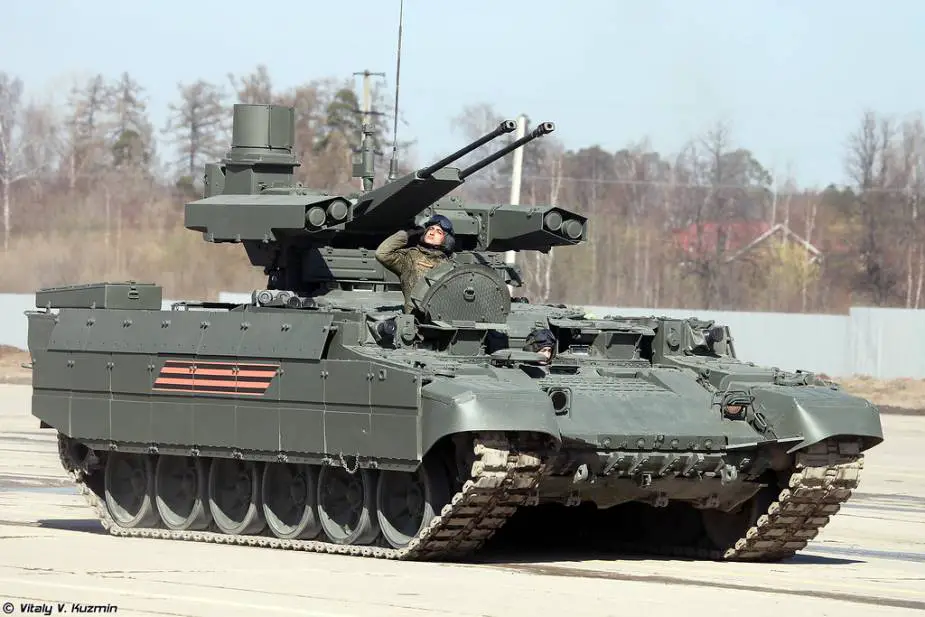The BMPT concept emerged in the 1980s and actively developed because of the war in Afghanistan and then in Chechnya. It was initially planned to create a combat vehicle with various arms to destroy antitank weapons in a single combat formation with tanks. The design was several times suspended, but BMPT supporters each time succeeded to have it resumed.
Follow Army Recognition on Google News at this link

BMPT "Terminator-2" fire support vehicle (Picture source: Vitaly Kuzmin)
The issue of direct tank support in the battlefield and on the march is not new. It is at least 80 years old. World War 2 offered a possibility to test the concept of tank support by combat vehicles on the march and in the battlefield. Self-propelled antiaircraft guns defended the tanks against air attacks. When the German army (both Wehrmacht and Waffen-SS units) received more powerful tanks, the Red Army had to urgently form self-propelled artillery regiments. They were assigned to armor corps and played a major role in escorting T-34/76 tanks (T-34 tank armed with a 76mm gun). In late 1943 – early 1944, new Soviet tanks with 85mm (T-34/85 and KV-85) and 122mm (IS-2/Joseph Stalin2) guns were produced. Their firepower was on a par with the German Pz.Kpfw. V Panther (75mm) and Pz.Kpfw. VI Tiger I and II (88mm). After the war, improved tanks were designed and there was no longer any need for self-propelled antitank guns (unlike the newly created Bundeswehr did with Jagdpanzerkanonen, JPK).
The most successful engagement option of the self-propelled guns was to follow advancing tanks at a distance of 300-600 meters and support them by fire at brief stopovers. The guns destroyed adversary firing positions by high-explosive fragmentation shells to break through the defense and fired armor-piercing shells if the adversary counterattacked.
It is necessary to comprehend how to engage BMPT in a real clash. Concept designers proposed to replace infantry. Now they propose that BMPT should support infantry and advertise it as a fire support combat vehicle at international arms shows.
Which missions can BMPT fulfil? It destroys armor at major distances by Ataka missiles and can operate at the frontline like a tank due to the armor. However, BMPT capabilities to fight aircraft are limited. The vehicle has no radar or other means to detect air targets, which decreases fire effectiveness. Properly trained helicopter and jet pilots can destroy a tank column with or without BMPT. The situation is even worth if modern combat drones attack.
Ataka missile is the main antitank weapon of BMPT. Russian tanks have been long armed with antitank Reflex, Ivar, etc. antitank missiles fired from 125mm smooth-barrel gun. Ataka has no major advantages. It has a longer range, which is difficult to use in Europe. BMP-2M is armed with automatic guns and grenade launchers and the upgraded vehicles received the launchers for four latest Kornet rather than Ataka missiles. BMPT exceeds BMP in protection, but is inferior in mobility.
In a word, BMPT concept offers no breakthrough. If it is not limited to the 12 vehicles of the initial contract and Uralvagonzavod finds customers in Russia and abroad, the hardware is likely to be upgraded from the available tanks rather than produced anew. The talk is about T-72 undercarriage of previous and morally outdated modifications. They cannot return from warehouses without an upgrade by modern requirements. The customer will have to decide whether to choose modernization and keep the initial designation or remake the vehicle into BMPT.
The remake does not promote BMPT deliveries to the armed forces. The task is not easy and demands many months or years of hard work in the headquarters and in training ranges. The delivery of the first serial units of the new hardware is inspiring in this aspect, the Independent Defense Review said.
© Copyright 2020 TASS / Army Recognition Group SPRL. All rights reserved. This material may not be published, broadcast, rewritten or redistributed.














